

You may have noticed late last year the AANA broadened their official definition of “advertising” beyond that of a paid-for message. To reflect the changes the Internet has brought about, they now refer to “marketing communication” activity as brands are now often engaging in two-way conversations, not just pushing messages one-way via ads.
Early this year CommBank’s CMO Andy Lark, an ex PR man himself, told PR agencies they risked losing their traditional area of expertise to digital experts and integrated agencies.
The issue for businesses isn't simply which external supplier or internal staff is running your social media. With new technology comes a lack of control over how customers choose to seek information and engage with you, which brings a new level potential for confusion. And just as there is confusion around whom within a company or it’s preferred communications partners should be in charge of the conversation, the laws we all operate under right now are equally confused.
Who is responsible for comments posted on your business Facebook page?
In response to an ACCC ruling and fine of a liquor brand for leaving comments on it’s Facebook page deemed to he inappropriate, the AANA extended the reach of its Codes to cover most forms of advertising and marketing communication over which the advertiser or marketer has a reasonable degree of control.
In two recent determinations dealing with brand-owned Facebook pages, the Advertising Standards Board (ASB) reflected the AANA’s intent and stated:
“The Board considered that the Facebook site of an advertiser is a marketing communication tool over which the advertiser has a reasonable degree of control and that the site could be considered to draw the attention of a segment of the public to a product in a manner calculated to promote or oppose directly or indirectly that product."
"As a Facebook page can be used to engage with customers, the Board further considered that the Code applies to the content generated by the page creator as well as material or comments posted by users or friends.”
While you may think this ruling is a bit rough, at least you know where you stand. Until this week.
The AANA at least gave clarity, we now have a contradictory new set of guideline by the IAB
“After a careful analysis of existing laws and regulation and industry practice around social media IAB Australia has reached the view that user comments directed towards an organisation or social media platform, or to other users who are drawn to a particular organisation, do not constitute advertising,”
According to Samantha Yorke, director of regulatory affairs at IAB, “There is a real risk that organisations who treat user comments as advertising will err on the side of caution and moderate user comments very conservatively, which will adversely impact their presence on social platforms and which arguably undermines the very spirit under which social media thrives,”
I wonder what a judge will say about a marketer’s immoderate management of a social media campiagn in a yet to be held ACCC hearing?
UNO is one of a small number of marketing communications agencies accredited by The Communications Council of Australia. We believe self regulation only works when all of our customers' messages within our control are held to the same highest standards of paid-for and signed-off ads, irrespective of whether published in a traditional, new or yet to be invented medium. At least that way our clients have minimised their risks, both known and unknown.
Read More
There are many tips and how to guides claiming they have the key to revealing the relative strengths and weaknesses of where to advertise, promote and connect. Media sales reps have a long history of presenting charts and graphs that show their medium in a favourable light. To ensure the best ROI marketing, we only rely on those studies that have rigorous methods and meaningful numbers to make the findings reliable.
Don't trust every media benchmark you can Google
For those who want to know what medium is most effective at acquiring new customers in the digital era, here is a chart we feel is valid:
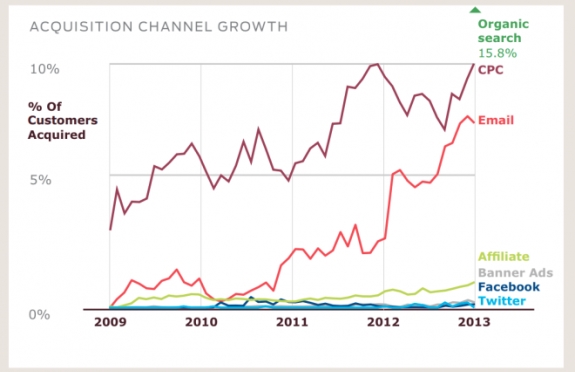
Trend in performance of digital channels for acquiring new customers
Custora came up with these figures by analysing data from 72 million customers shopping on 86 different retailer sites. They tracked where customers were clicking from (email, Twitter, Google, etc.) and what and how much they bought, not just on that visit but for the next two years.
Over those two years, Custora found that customers who came to retailers from search were 50 percent more valuable than average. In other words, they were more likely to shop more and spend more. Email customers were nearly 11 percent more valuable than average. Customers who came through Facebook were just about average. Twitter customers, meanwhile, were 23 percent less valuable than the average during the two years following that first click.
I've written before that our reluctance to spend clients' money on banner ads is based on one amazing fact: you are more likely to win Lotto than click on a banner ad.
In comparison to these digital channels, research by the Direct Marketing Association shows you may still be best served with good old direct mail:
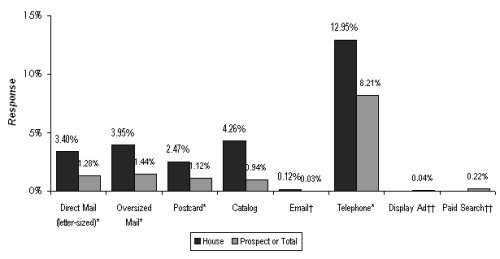
Average response rates for direct sales, DMA 2012
There is one new piece of research though that ultimately makes the discussions about differences between media effectiveness become a secondary consideration. It's proof of what many of us have always suspected.
How you craft your message is more important than the medium
The latest research into advertising effectiveness in Australia has proven creativity makes a big difference. The Association of Data-driven Marketing & Advertising shows that after 12 months ads with better ideas are both more effective and increase a brand's ability to harden pricing.
This reminds us you’re potentially wasting your time and money if you don’t get your pitch right. As consumers we remember big ideas, like “Think small.” Or the pulling power of a well crafted headline like “It’s Time.” Or a picture worth a thousand words...
The truth well told has been proven yet again to be more important in getting the best ROI from your marketing than any optimisation techniques digital specialists may dazzle the bean counters with. We are not animals, we are human, and we respond to emotions, not numbers of targeted exposures.
For those who want to make the most of their investment in airtime/space/or face-to-face, remember to invest a little in the art of communication.
It's not just consumer brands that can benefit from better communication
An ability to express your message is just as impotant for both service businesses and B2B. This is especially true for financial services, as shown by this chart of what customers say are the most important qualities in a financial adviser.
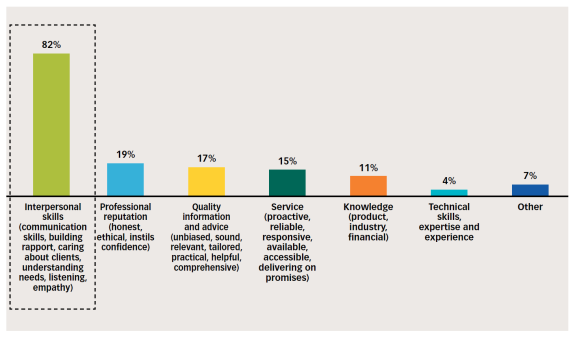
AFA White Paper: The Trusted Adviser May 2013
The report found the biggest difference in success of the top 10% of financial planners and the rest isn’t expertise, or credentials or technology – it’s the ability to communicate. Communication is not talking at people, it's the art of speaking with empathy. This is where social media excels. Use it to listen to your customers, then respond in a way that makes the individual believe you understand where they are coming from.
Irrespective of digital or traditional, face-to-face or in writing, where you have the conversation is secondary to the way you express yourself.
Just remember to make the message suit the medium. Our burping cow ring tone for Sipaah was downloaded by lots of kids who knew exactly where our brand was coming from.
Read MoreFame is the game of the name


The exponential pace of change is increasing the pressure on businesses to stay competitive. You know it’s not going to slow down. Fortunately there are still ways you can take control. One proven method is to revisit some simple building blocks to help make your brand relevant in today’s complex marketplace.
4 step process to make a challenger brand famous:
GAME
NAME
FAME
CLAIM
Game:
When did you last define what it is you do you do that makes you a specialist. In a cluttered business environment it pays to play in a defined niche where you know more about the rules of the game than your competition. Define the things that are of value to your prospect. Make sure you understand what it takes to be world’s best at your game, and work to stay at the top. People will still pay you a premium for something special that means something special to them.
With a fresh outside perspective, define your true differentiators, your “authentic truth.”
Name:
Your reputation, the brand and everything it does must be aligned with what you do that is special or your efforts will be diluted. Today, any business with integrity can compete against established incumbents. The cost of entry is no longer big budget mass media campaigns, the spoils now go to the nimble.
Today, the truth is what counts, the public can find the facts faster than businesses can attempt to shape opinion. Ensure your brand reflects your truth in everything you say and do.
Fame:
The art of being noticed. And remembered. And talked about.. You can do this several ways. Spend a lot of money, like Swisse, who invested up to 60% of annual revenue to marketing to achieve business growth, which stands at about 50% year-on-year over 4 years.
Or take the stand out in the crowd approach. An elevator pitch is only of value if people are listening, be too polite and you will be invisible. There is something to be said for the fart in a lift approach, however can you risk going viral with the wrong tone of voice?
Ideally, you can take the hero approach: be noticed by the right people for the right reasons. To do this ensure you choose the right medium for your message. There have never been so many communications options – a pitfall for the unwary, and an opportunity for the savvy
Claim:
Tell the truth, especially now the customer can search the Internet to discover what is a genuine claim and share with their friends what they find out. Decide what will differentiate you in your game – do you do it faster or smarter, cheaper or better?
Then find a creative way to express your difference. As J Walter Thompson said almost a century ago, “the truth well told” is the value add of great advertising.
Famous campaigns start with a defined customer benefit
What’s your “Which Bank?” How will you enter the vernacular, as this one of mine did 25 years ago:

With a creative leap, you can express the human insight that will resonate with your prospects. And they’ll repeat it to friends, again and again.
Read More
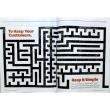
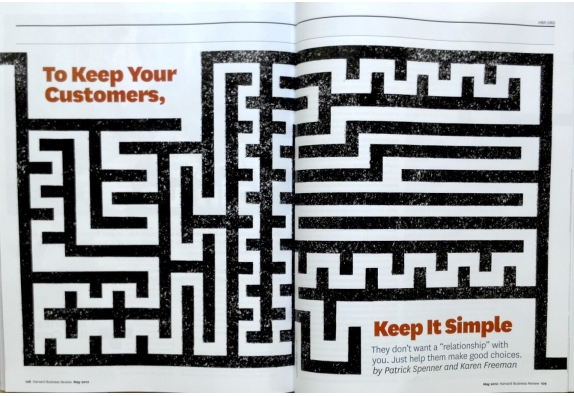
How do you explain to the manager who signs off your budget that today customers want more from your website than a brochure online? You can start by pointing out how you can replace existing fixed and recurrent costs with keener priced digital alternatives. Then remind the cost controller that technology is moving so fast they’ll be surprised how much more you can do today for less. A lot less than many of the savings to be made across existing business practices that digital can now enhance or replace. This 12 point digital checklist can help you keep it simple and the returns substantial.
Your digital project 12 point checklist
Keep an open mind, what the site needs to include is based on what the customer wants, don’t limit scope by prescribing whats to be included by your what your preconcievd ideas of what the competition have already done.
Engage with the user in the context of where and how they are accessing you. Are they on a mobile while in a shop, in bed on a tablet or at their workdesk on a PC? At work, at home, on the move, your site experience needs to change accordingly.
Educate or entertain? Ask yourself are they visiting your site to learn more, or simply because it is an enjoyable experience? Or would they like it if you did both? Deciding this helps shape your content and navigation.
Personalisation. "Allow users to personalise their experience. People love to add personal touches because it helps them feel at home and in control. Provide sensible, beautiful defaults, but also consider fun, optional customisations that don't hinder primary tasks." - Google Android
If you don't treat each customer as an individual, a competitor will. Technology now enables you to serve each visitor exactly what they want, a bespoke site just for them.
Innovate.The digitisation of everything now allows you to reinvent so many of your business functions and methods, take advantage of what is now possible.
Tone of voice is more important than what you say. The way the site looks, the colours used, typography, whether there are pictures or videos and the style of vocabulary you use will make a bigger impression about your brand image than what is in the text.
Services is what you build today, not websites. "Our service doesn’t begin and end at our website. It might start with a search engine and end at the post office. We need to design for that." - GOV.UK
Iterative, our most used word to describe our process for scoping, designing and building a digital service. Start small, constantly evolve and develop the service offer. We learn and improve the offer together as we go.
Marketing. A site without marketing is an island resort that’s not on any map, let alone an itinerary. Don’t launch and leave, have a plan that will drive customers and prospects to your site, align what the promise is and how your site will deliver to expectations.
P, there are 4 of them in marketing: Product, Price, Promotion, Place. Consider which of the Ps is most useful to enable you to best engage with each type of customer. The 4Ps of marketing aren’t all the same for every person or every occasion.
Load time is more important than looking good. Too many fancy things can slow down the experience.
"Make important things fast: Not all actions are equal. Decide what's most important in your app and make it easy to find and fast to use, like the shutter button in a camera, or the pause button in a music player." - Google Android
Effectiveness. Know what you want to achieve and why. Most importantly decide how you will measure with meaningful metrics that can be acted upon. Then you can build in measurement techniques to track what is working and what needs to be improved. And make sure someone is in charge of tracking results and implementing improvements.
If in doubt about what matters most, remember the customer's perspective comes first. Look at the first letter of our 12 points. In an increasingly complex world, when you connect with customers they will appreciate it of you can KEEP IT SIMPLE.
Read MoreRadioactive ads from when people didn't know better

Classic ads from 1910-1930 for radioactive products
What can’t radium cure? A century ago it was legal to advertise radioactive products, from toothpaste to suppositories, condoms and check out the chocolate!

If looks could kill: Radium lipstick advertisement from the 1930s. (via 109.com)

More classic ads from the 1930s for the Tho-Radia range of makeup.

Nil by mouth, guaranteed harmless?!! Gives new meaning to "the ring of confidence"

Anyhow, have a radium.

Now in a convenient pocket size pack of 20s. They didn't know smoking kills.

Mrs Marsh could give us a demonstration of the brighter effects on your smile of Radium toothpaste.

Chockaholics aren't left out, Radium is everywhere. The ads claimed eating a block would make you look younger.

Time wasn't on the side of those with radioactive numbered watches that glow in the dark.

Another ad campaign competing for share of the toothpaste that glows market, now with added thorium.

Radioactive wool keeps you warm on the slopes.
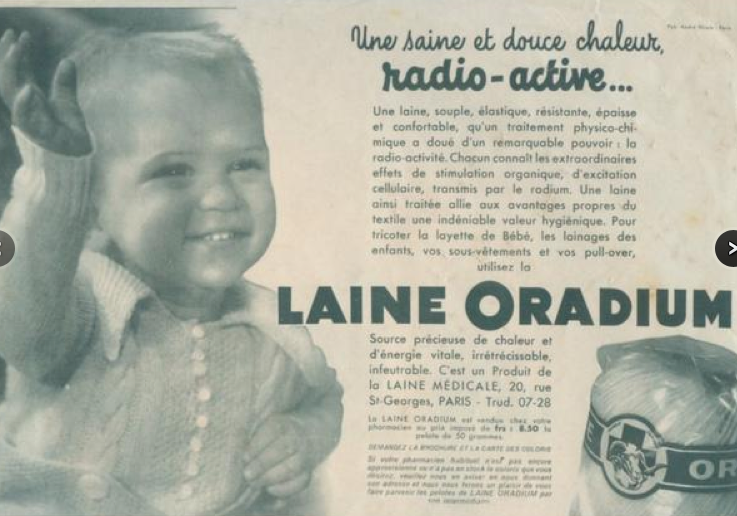
Dress your baby in it.

Advertised as a cure for arthritis, rheumatism, mental illnesses, stomach cancer and impotence. (via Real Food University and Oak Ridge Associated Universities) Triple distilled, who needs a whickey chaser?
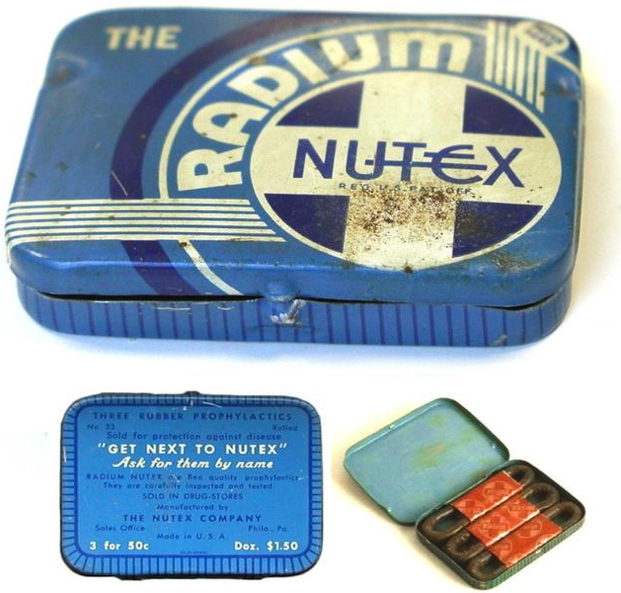
Condoms, that glow in the dark?
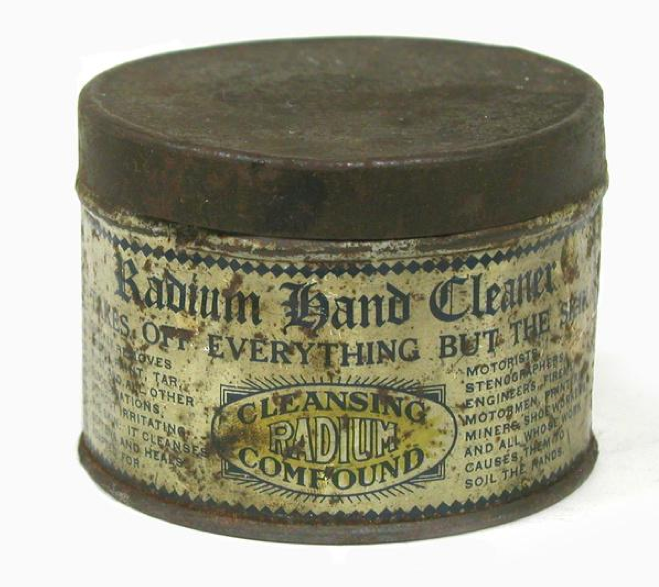
They didn't realise you can't wash off radiation poisoning.

Dr Curie started something big. Cosmetics companies continue to claim they have the secret to eternal youth.
Like to see some more classic ads?
Have a look at 12 great vintage politically incorrect ads for Christmas gifts.
Read More

Everyone knows the way to lose weight is to eat less and exercise more.
Yet year after year most Australians are getting fatter. Fatter people aren’t as healthy. Fatter people die earlier than fitter, leaner people.
A whole industry makes money out of fat. Fitness clubs. Personal trainers. And diets. None of it works over time. The stats prove it. It’s not enough to know you have a problem. Personally I have never been better educated, yet I’ve never been so overweight.
Science has shown only cognitive behavioural therapy ensures long-term positive change and a healthier longer life as an ex-fatty. 21 days of mind reprogramming is just the start to breaking the usual fatso habits.
Business as usual doesn’t work. How long till the business you work for dies?
Australian businesses are fat. They aren’t fit enough to cope with today’s rapid pace of change and increasingly complex issues. They don’t exercise their brainpower by trying something new. And like most of us with a weight issue they are looking for the quick fix. So they outsource it.
The diet industry equivalent in this instance are the service providers, from the Deloitte pre-prepared meal programs and the peddlers of management boot camps, to the efficiency fitness trainers selling the benefits of Sigma 6 and Lean. Even the language is the same as The Biggest Loser.
The answer for struggling businesses isn’t in doing the same things more often, or paying more personal trainers to lift your motivation. Nor is it enough to reduce the excess fat by cutting costs. Stomach stapling the business results in staff suffering reflux, hunger pains and mental stress for no performance improvement.
The answer is cognitive behavioural change.
The answer is developing an innovation mindset.
Here’s how it works and why most businesses are doomed to die early.
It starts with the owners of the business recognising they have a problem. An attitude problem. Their brains have been thinking the same way so long their synapses have turned a well-worn groove into a rut of superhighway proportions. The problem is, it’s now a road to nowhere.
The new business opportunities aren’t where the brain has become accustomed to drive to, every category is seeing their marketplace become a ghost town. Today’s marketplace is somewhere new, and management not only don’t know where it is they don’t have a map to show them how to get there.
The new destination is growing, profitable and exciting. It’s enabled by the Internet and feeds on new ideas made possible by software as a service, unified comms and the cloud. The new place isn’t a city or a country or a category, it’s everywhere and anywhere the customer happens to be, 24/7. Now every customer or prospect can pick and choose what they want via a mobile device. From cat food to cars, retirement plans to restaurants, you can research and purchase without talking to a salesperson.
Yet business owners continue to think the value of their business is existing fixed assets and legacy systems, current supply contracts and distribution arrangements, proprietary processes and procurement systems. Australian managers continue to tweak a little here and there around the edges of their business models. Generally, the bigger the organisation the more cholesterol blocked the arteries of internal management and external communication.
Figuratively speaking, fat dead men walking the corridors of offices around the country are about to be knocked off by fit and nimble female and new age male entrepreneurial thinkers who are open source and open minded.
So what do our business leaders do? They buy another diet book, like the biography of Steve Jobs. What they don’t realise is reading about Apple is as relevant to middle managers as middle aged men reading about Usain Bolt’s exercise regime. Apple was a challenger brand from day one. It was in the DNA.
The answer isn’t reading a book on what someone else has done. It comes from doing what hasn’t been done. It comes from the confidence to try something new with a willingness to fail. Accepting you’re likely to fail again and again. Because continuing to do what you do now is guaranteed to fail. While with every new thing you try your chances of discovering a winner increases.
Changing your habits and practicing to do what doesn’t come naturally, every day, is the proven method for success. It’s making a habit of taking small risks often so you don’t stand still and become another Kodak. The proof is in understanding how Fujifilm could innovate itself a future as a cosmetics company.
Memories might be priceless, they just don’t make money like they used to.

How a traditional business became a challenger brand
Fifteen years ago Kodak entered a death spiral, from a global peak in 2000, camera film sales dropped 90 per cent in 10 years as the digital revolution swept the world. “We’d known it was coming since the 1980s,” says Yojiro Yamashita, general manager of Fujifilm’s life science products division.
Kodak didn’t make it, going bankrupt last year. Fujifilm not only survived but emerged into the digital world of today with a series of innovative new businesses.
Fuji recognised what its’ true strengths were says Tomoyuki Yamazumi, a cosmetics industry analyst for the research firm Fuji-Keizai. “It had the financial power plus a strong marketing ability and existing ties to consumers.” One of the small risks Fuji management took was launching a cosmetics range in 2007. By 2010, sales of Fuji’s upmarket Astalift brand were already over $100million a year. By 2018 the company is looking to increase skincare and supplement sales by ten times that.
Look around your business. Are you a Kodak, or can you recognise your strengths, try something new and innovate your way to a future as a challenger brand?
This article first appeared in AdNews, 30/5/13
Read More

At CeBit 2013, Salesforce Vice President Vivek Kundra’s big question for Australian leaders is “how can a country of 22 million people compete in a world of seven billion?” His answer?
“It’s not about size. It’s going to be about innovation. Innovation policy and an innovation agenda have to bethe come building blocks of a nation that’s going to compete in the global economy.”
Third wave of computing is changing the global economy
Competition in the global world of business is being driven by a ‘third wave of computing’. Essentially the shift from hardware to cloud based software and services and super fast mobile broadband networks that allow consumers and workers to access data on portable devices. Our clients have seen a doubling of visits to their websites from mobile devices over the last year. In fact, this year more people globally will access the Internet from a mobile than a computer.
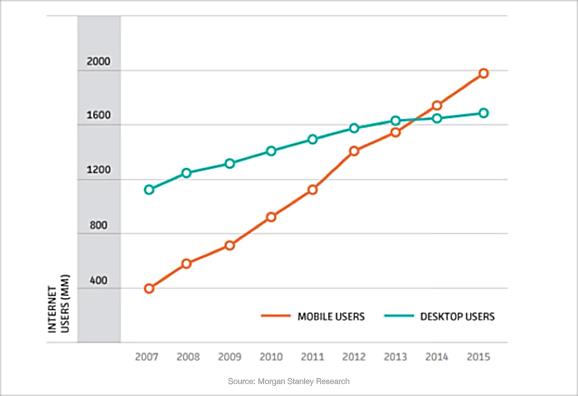
The opportunity for challenger brands
The biggest risk for businesses I’ve observed are the internal stakeholders defending their hard fought for legacy systems and infrastructure, and managers who are obsessed with efficiency through fine-tuning traditional methods. As Kundra points out, competitiveness now comes from letting go of what you’ve currently got now. “Most large scale organisations are still stuck in 1980s technologies. If you’re still stuck in an old mindset then unfortunately there’s a young entrepreneur who is imagining the way the world should be rather than it is.”
“The most amazing opportunities lie in reinventing entire sectors of the economy.” Vivek used the usual examples of US companies like Amazon, Netflix and Uber as businesses that are challenging categories today.
If you are running a business you have a clear choice he says – “do you want to be Amazon or Barnes & Noble?” This isn’t a particularly new view, as a global survey by Boston consulting summed up a couple of years ago, in this world of rapid change the spoils go to the nimble. Still, many managers still don’t seem to be responding.
“There’s a Darwinian spirit to the extinction of those who are holding onto the 1960s ways of doing business.” Vivek states, “not because it’s in the interest of the customer but because it’s easy and it’s because that’s what they know what to do.”
A marketer’s mantra for today: “The customer. The customer. The customer”
This is the biggest differentiator for challenger brands. “Companies that are embracing the third wave of doing business are doing it in the interest of the customer.”
Kundra recognises the fear of change within businesses when he suggests the best way to introduce a change culture is to build a prototype. “I think for too many people the expectations for transformative technologies is that it takes too long, costs too much and they’ve been burned in the past.”
A test and learn approach reduces risk
Last week at the launch of an AGSM Mid-Market program a professor specialising in innovation for business pointed out success today comes from having a portfolio of new initiatives that can be tested quickly in the marketplace. Rather than over researching only one strategy in an attempt to minimise risk, be willing to fail and fail frequently. The chances of some prototypes being winners with the customer will increase the more you try.
As Kundra says, aim to “be relevant and simplify the customers’ or citizens’ lives”.
Read More

The latest statistics on online fashion retail sales, research on the main purchase driver for financial advice and a Californian think tank pricing model all give marketers strong reasons to reconsider Price as a useful tool.
Evidence 1: Online fashion sales prove price not the motivator
No wonder Australian retailers are scared of online stores. British online retailer ASOS recently revealed that Australia is its single largest foreign market — with Australians buying something from the ASOS website every 6 seconds. The latest research from Roy Morgan shows at December 2012, 7.6% of Aussies aged 14+ (or 1,430,000 people) had made an online fashion purchase in any given four weeks — up from 5.7% (1,062,000) one year earlier.
Online fashion-purchasing habits by Australian women by sub-category, 2011-2012
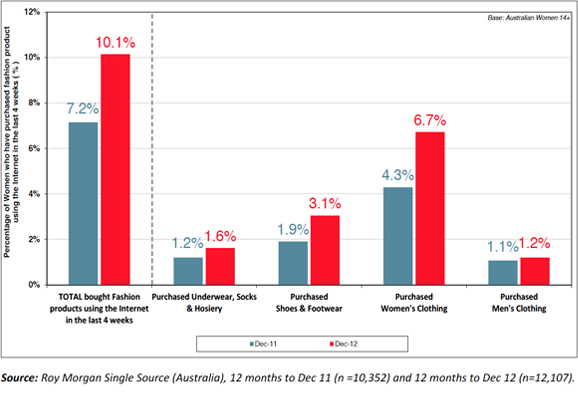
What is really interesting is the opportunities for marketers this research reveals. Most people would probably jump to the conclusion that these online sales are being lost by Australian stores because clothes are available cheaper from overseas. Everything on the web is cheaper, right? Well actually, no.
Roy Morgan’s research has found “scoring a bargain is not the main motivation for women purchasing fashion products online. Far more important is quality, with 75% of them agreeing with the statement ‘I believe quality is more important than price’.”
Discretionary spending by women on clothes has parallels with the way men seek financial advice. A recent national survey by an independent network of financial advisors found the vast majority of customers were more concerned about the quality of service and the frequency of face-to-face time they received than the size of the fee. Of hundreds of customers surveyed, price was rarely mentioned. Value was the primary concern, and the value equation was grounded in the perception of the quality of advice. .
None of this is new. I’ve been segmenting customers using the New Economic Order for nearly two decades since it was first developed by two Australian academics.
Evidence 2: choose who you want to be your customer
You can segment the population by three distinct sets which allow marketers to predict discretionary spending behaviour. The biggest segment, the Traditionals, sre generally cash poor with most of their spending accounted for with essential services, utilities bills, rent, transport and food. They have neither the capacity nor the predisposition to purchase discretionary items.
The other half has a common mindset, they share a desire to buy quality goods and experiences. This group is divided in half by their capacity to spend, one half are NEOs, and while they are only a quarter of the population they represent half all discretionary spending. Transitionals are NEOs on a limited budget: a career couple with one at home with a baby, or a high achiever that's just started their own business, or perhaps they have retired.
For 50% of consumers, the Traditionals, a cheap price is their opening and closing consideration. However these are the people who don’t spend much. They also deliver no sense of loyalty and don’t refer new customers. Every sale to a Traditional is a new sale that starts from scratch. And risks going to the lowest priced competitor on the day.
Most restaurant and airline customers and B2B purchasers are NEOs. These people research purchase decisions on the basis of what they believe are the features and benefits that mean the most to them. Price comes LAST, and isn’t much of a deal breaker.
Those latest stats on online fashion sales make sense in light of NEO behaviour. NEOs are online researching what’s hot in the world of fashion. In fact, it’s where they do most research when considering any major purchase because it’s where they control the levers, avoiding the unsavoury hassle of being sold by a salesman face to face. While Traditionals continue to spend the majority of their clothing budget on essential items like socks and undies in stores when the sales are on, NEOs continue to buy more discretionary fashion items, more often, both from the Internet and instore.
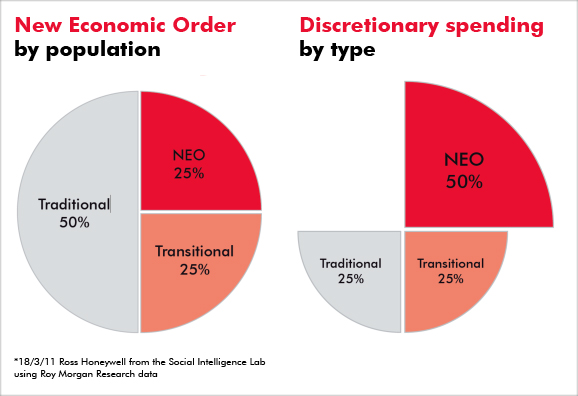
So what’s the best marketing model for selling to NEOs?
Evidence 3: all value is subjective
According to Ron Baker, the founder of Californian think tank the VeraSage Institute there are two fundamental approaches to pricing:
Cost-Plus Pricing
Labour Theory of Value
Product » Cost » Price » Value » Customers
Pricing On Purpose
Subjective Theory of Value
Customers » Value » Price » Cost » Product
You can see how subjective value pricing turns the order of cost-plus pricing on its head, by starting with the ultimate arbiter of value – the customer. In Baker’s words: “Goods and services do not magically become more valuable as they move through the factory and have costs allocated to them by cost accountants. The costs do not determine the price, let alone the value. It is precisely the opposite; that is, the price determines the costs that can be profitably invested in to make a product desirable for the customer, at an acceptable profit for the seller.”
As a marketer, for decades I found software one of the simplest products to approach from the Pricing On Purpose model; it’s the only reason Microsoft had education, standard and professional versions. The mid range product best reflects a fair margin for the cost of production of the product. The same product is then also sold at a low entry price with a few features turned off to maximise sales volume at the low end and repackaged in a fancy big box with a few extra features to maximise margin at the upper end of the market.
Choose who you want your customer to be, only then pick a marketing P
Whether you are selling clothes or cars, fair trade coffee or boutique wine, building materials or investment services, remember when your sales force wants you to discount, ask them to stop and think about the customer. Are you selling a basic product to a student, an authentic experience to a Transitional or a professional service to a NEO? Agree with sales who your customers are before you decide to use the PRICE lever.
Depending on who your customer is, Product, Place or Promotion may be more valuable to them than Price.
Read More

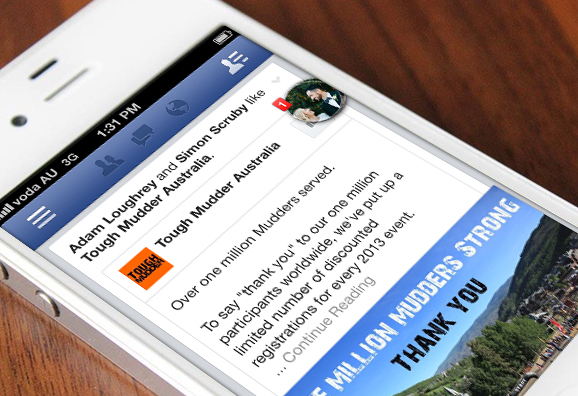
Just being active on Facebook isn’t enough. As with any communications medium, there are smart ways to achieve more for less effort.
Don’t be baffled by social media marketing spin doctors. Sure, Facebook has it’s own set of best practices. Hopefully by getting to know what matters and what doesn’t you can ensure any supplier will make the most of your investment.
The key to making the most of Facebook for your business is understanding it’s all about making sure everything you do improves your chances of being seen.
Much of this isn’t about paying for black art, it’s about basic step by step craft.
40% of time on Facebook is spent on news feeds
Only 12% is spent on profile or brand pages. So:
- Post articles on other people’s pagesPost on less pages more often
- Choose pages with high numbers of fansPhotos have higher ranking than links or text
- Use images
- Keep your text posts short – between 100 to 250 characters get 60% more engagement
- Ask a question
- Post daily and frequently
- Post about relevant topics – don’t push the brand
- Test your audience for their engagement times – 18-24 year olds are most active 9pm – 10pm, women 25-45 even later
How edge-ranking works is the key for marketers
All of these individual steps are only important because of something called edge-ranking. This makes or breaks social media marketing. This infographic shows how it works.
Read MoreThe health checklist for your sales process

15 questions to help your business determine the focus for your sales activity.
Do you have a sales department? Here are 15 questions to help change your sales force from sales takers to sales makers:
- How much time are you investing in new business a day?
- Is the total revenue and the sum of your clients’ budgets growing more slowly than in the past?
- Will growth levels come from present client budgets?
- Where will growth come from?
More frequency of purchase
More volume of each sale
More value? Up sell/or cross sell? - Will growth have to come from new business won from competitors?
- How do you sell to prospective clients?
- What’s your process?
- How do you find them?
- How do you win them?
- How do you prioritise sales calls?
- How is a sales call pre-qualified, (telesales/email/CRM)
- How long is spent face to face?
- What is your conversion rate?
- Is the sales call to the final decision maker?
- Who is the primary decision maker, how are they managed?
ROI marketing can help improve the performance of any of these sales metrics.
Marketing can speed sales, pre-qualify and build loyalty once you’ve made a sale.
In the past business owners were frustrated by an inability to measure what worked and what didn’t. Today there are tools and technques to enable you to measure the return on your marketing investment.
Read MoreWhy the CEO has to be the chief blogger

Successful social media strategy starts at the top of every business
It's misguided to think social media can simply be delegated to the youngest in the business, or outsourced to a digital agency. Social media is simply another relationship management channel. So it makes sense the strategy of what will be discussed in social media and what won't lies with the CEO. Social media is the one place the CEO's message can get through direct to the individual, without being filtered.
So if you're the CEO, consider this medium as your direct way to have a personal conversation where you can champion what you believe in. Before you begin, reconsider what you want your business to be known for. Ask yourself what is at the heart of why people should buy from your business, rather than your competitors?
Recent research by PR firm Weber Shandwick shows social media has positive impacts on business. (Click to enlarge.)
This simple checklist will help frame the social media agenda for your business
- What is the purpose of the business, what will success look like?
- What is the business strategy?
- What does the business believe in?
- How does it add value?
- What are its beliefs and ethics, its reason for being, its mojo?
- What is the business story? The way you express your differentiation, the reason for customers to choose you.
- Who does the business want to help? Who do you want to leave for your competitors to lose time or money trying to please?
- Who does the business want to influence? The gatekeepers to your prospects, or perhaps the well connected people who might bad mouth you through ignorance?
- Who does the business want to work with? Do you have affinity partners or associations you can share your blogs with?
- What kind of people does the business want to attract? It now matters what you look like in the blogoshere because it's the first place most potential employees will check you out.
Reputation risk has been elevated by social media
As equally important as having a social media presence is what you say. Being active across social media brings new risks. What is published online stays online, potentially forever. No wonder reputation risk is now the number one concern of CEOs globally according to the latest report from Deloitte.
Perhaps if more CEOs took control they would minimise the risk of staff who know less being the main originators of social media conversations. The CEO is best placed to set the agenda, staff can then follow through.
According to research by Weber Shandwick, more than six in 10 CEOs are already posting content on company websites. Yet only 18 per cent of the CEOs surveyed participated on social networks. The chart above gives an overview of the survey findings. Interstingly, 80% of staff want to see their CEOs on social media, largely because it's where they want to keep up to date.
I feel most CEOs I talk to are missing this powerful opportunity to spread the truth about their business vision. Social media is where these truths are shared and discussed, it's one place the leader can champion their cause with passion.
Read MoreWhat makes mid-sized businesses more profitable than big?

So what is a mid-sized business?
GE Capital has been defining the mid market in Australia as businesses that have annual revenues of between A$10 million and A$250 million. Average firm turnover is about A$41 million. Despite comprising just 1.4% of companies by number, mid-market firms provide one in four full-time jobs and contribute A$425 billion annually to the economy.
The federal Department of Innovation, Industry, Science and Research, which has a broader definition of medium-sized businesses as those with between 20 and 199 employees, puts the economic contribution of the mid-market considerably higher.
The mid-market campaign we successfully managed over four years for IBM targeted businesses from 99 and right up to 999, the large corporate and government sectors that IBM traditionally owned really kick in around 1,000 staff.
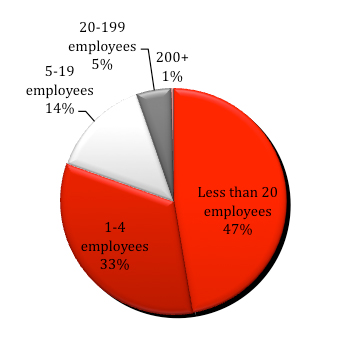
Australian Business
Most mangers still hold the belief big means better. We hold a belief businesses can only succeed today by being nimble. The reason for this is the profound change the Internet has brought to our lives. The world even quite recently was quite slow to change, and most businesses were relatively simple. Today we all compete in a world of rapid paced change and increasing complexity. So the old big business model of slowly and effectively finding savings from gradual improvements to products and services and small efficiency gains in management and procurement are no longer enough to stay competitive. Let alone stay in business.
The evidence for the decline in profitability of big business is seen in this chart. It shows one third of market leaders in their category in 1950 were also the most profitable businesses in their category, whereas today being big almost guarantees you’ll be struggling to make a buck.
Market leaders that are also category profit leaders:
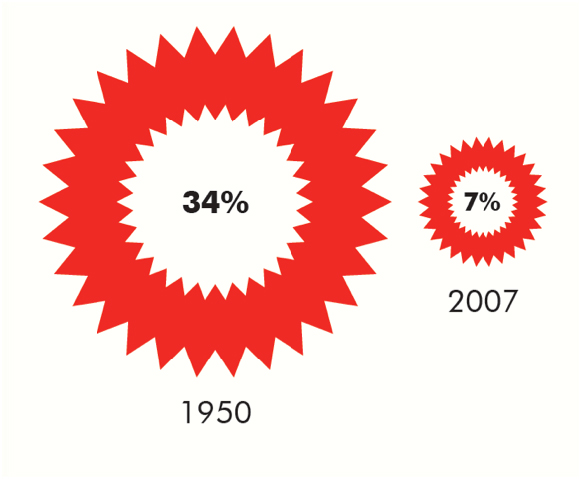
What makes big business vulnerable to challenger brands
George Shinkle is a Lecturer in the School of Strategy and Entrepreneurship at the Australian School of Business. He has been studying why big business is failing.
“Organisations grow large by becoming more efficient, so when you’re really focusing on efficiency you typically become less and less flexible. The rules and processes and procedures become more and more about keeping you efficient, constraining your ability to be flexible,” he says.
“If you talk to the CEO of a very large firm, they don’t feel as if they’ve got direct control of what the organisation’s really doing. They give guidance and they set policy but the organisation has some variance on how well they follow those things,” says Shinkle.
The learning you can take advantage of is that managers in large companies try to hide from change. Which is why, if you’re running a mid-market business, you will create your own advantage by actively seeking out things to change to differentiate from the competition.
Not too big, not too small, mid-sized business is just right
Big business is still obsessed with conformity, groupthink and doing things the way they have always been done around here. Small businesses may be the birthplace of great ideas, but they usually don’t have the scale or resources to commercialise those insights.
The mid-sized business is perfectly placed in the middle, where the distance between innovative thinkers and management that can actually make decisions is short. Unlike small business, resources aren’t so slim ideas can’t be trialled without damaging the existing business of running the business.
At a CEO Institute meeting Susan Lenehan told me the biggest frustration of the CEOs of Australian arms of global businesses she mentors is their total lack of autonomy. They are prescribed what to do by head office irrespective of local circumstances. In her words, it’s the pinnacle of the “bully culture” of big business management.
Challenger brands will prosper by taking risks
This is the great opportunity mid-sized Australian businesses are exploiting, they can leverage their ability to try changes, while the big guys are stuck in the inertia of business as usual, with its five year plans, annual targets and quarterly reporting. By challenging traditional big brands, Australians can be globally competitive in a world that is changing daily.
The real successes come from maximising returns by minimising the risks of change – we developed the challenger brand formula for growth for this very reason.
Why you need brand awareness before sales

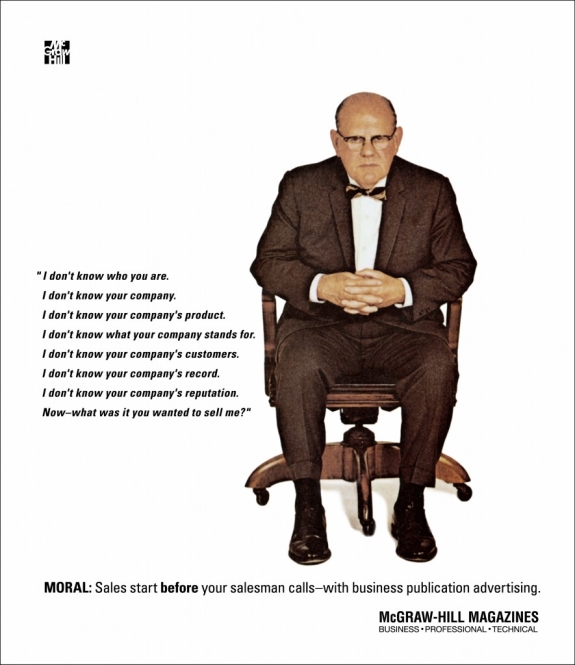
This famous ad for advertising with McGraw Hill appeared in 1958
Business owners sometimes need reminding of the timeless challenge, why would a prospect buy from you rather than one of your competitors?
For 50 years the simple answer was to spend more on advertising than the rest of your category. As marketers now realise, simple strategies in this Internet enabled world now require more complex solutions.
Challenger brands can succeed today without big ad budgets
The good news is smaller businesses can now be successful challenger brands with smaller budgets than the big brands. The staring point is to differentiate. with a singleminded story that prospects will value. you can then apply a test and learn approach to marketing across multiple mediums. Smarter strategies applied with insight will now succeed while big spending inflexible brands continue to struggle.
Read More73% of marketers say more has changed in 2 years than the past 50


Who are you going to call to advise your business on how to grasp the rapidly expanding number of marketing communications options? Usually you’d call in an expert. However, the pace of change right across the business world and the complexity of competing solutions is so great how can any individual be an expert? And big businesses may have lots of individuals, but we all know they rarely work as a team let alone communicate well with clients.
Marketing professionals are confused
A survey* by Adobe of 1000 marketers in the US shows the crisis in confidence of the marketing services.
“Marketers are facing a dilemma: they aren’t sure what’s working, they’re feeling under-equipped to meet the challenges of digital, and they’re having a tough time keeping up with the pace of change in the industry. What’s worse, no one hands you a playbook on how to make it all work,” says Ann Lewnes, Chief Marketing Officer, Adobe.
Digital marketing is full of novices
Adobe’s survey found less than half (48%) of marketers who consider themselves primarily digital specialists feel highly proficient in digital marketing. Most digital marketers haven’t had any formal training in digital marketing. No surprise really, it’s so new and evolving very few places can teach it.
The problem for business owners is how to leverage what’s new when so few people, if indeed any, know what will work. The people whose job it is to know, professional marketers, revealed in the survey the same old issues are today’s top challenges. 82% cited reaching their customers as the biggest challenge, then the uncertainty of knowing if their campaigns are working (79%), and measuring campaign effectiveness (77%) and marketing ROI (75%).
The answer for marketing your business?
Today every part of the business has to take risks
Whether it’s your accounting systems, distribution, IT or marketing, everything now is facing change. It’s hard enough to know the right question to ask anymore, let alone have the right answer. The safest option today is counterintuitive – it’s to realise you can’t predict winners anymore.
So the safe approach with marketing is no longer to set and forget. Rather than taking a long time and spending a lot of money attempting to develop the one perfect solution, try a lot ideas and mediums. And try them quickly and often.
Test. Learn. Adjust. Test again.
Learn to feel comfortable with failures. Set out to make the risks small so the stakes aren’t too high. Then go for it with a test and learn approach to marketing. The more often you fail the quicker you’ll find yourself challenging the competition and being successful.
* Source: Adobe and Edelman Berland, online survey among a total of 1000 US marketers. Marketing Staff (n=499), Marketing Decision Makers (n=436), Digital Marketers (n=263), and Marketing Generalists (n=754). September 2013
Read MoreAre fashion retailers training customers to buy on sale?
I've written in the past how Zara led the world by applying just-in-time manufacturing and data analytics to bring us fashion forward product design. This has given them an advantage over traditional retailers by circumventing the traditional seasonal approach to fashion.
Instead of waiting for the leading designers to reveal on the Paris catwalks what we'll be wearing next year, Zara's innovation was to take the Dell Computer model. Zara replenishes stock in their stores every week, see what sells, then make more of what is popular. Rather than sitting on large quantities of stock hoping people will like what style you've backed, Zara take a test and learn approach. They never back one colour or style for a full season, Zara simply adjusts what they manufacture on the fly to what the consumer wants this week.
Fashion challenger brands risk destroying the advantage they have created
Retailers are losing the power to maintain margins by encouraging a buy on sale mentality. According to Robin Givhan, the only clothes critic to win a Pulitzer Prize, with the constant turnover and turnout of items due to the ever-quickening fashion cycle, there’s no need to buy anything at full price anymore.
While bloggers and fashion critics have used social media to drive awareness and demand of the weekly fashion cycle, retailers she says are to blame for the loss of their pricing power.

"Retailers talk a lot about how the availability of show images pique the interest of consumers before the clothes are available. But I blame retailers for creating a system in which they want spring clothes in November and more shipments every five second[s] and then putting things on sale when they've only been on the racks for one second," said Givhan.
Consumers usually don't know how to establish the value of something, it's actually within the power of the seller to frame the price that they will believe is fair.
Innovate for pricing advantage
If you have innovated your way to a price advantage, don't throw away your smartly won margin. Instead, decide how you can frame the price as fair value, for instance in terms of more for the same, or faster for the same, or better for the same. Offering something for less is an approach fashion retailers are finding comes at the cost of not just profit, but long term survival.
Don't drive your category to the bottom the way Persian Rug stores have, where in every corner of the world the SALE sign on the window now means OPEN. Here's one I snapped in Hong Kong...
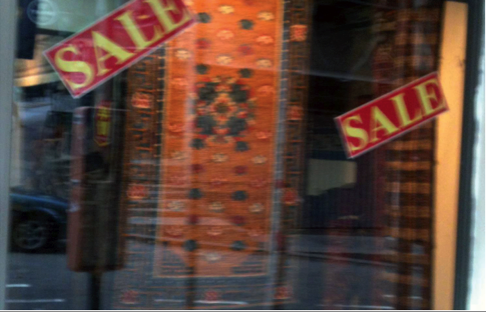
Do you have a clear point of difference to drive growth?


Staying in business has never been harder. 10,632 companies collapsed in the 12 months to March 1 2013 - ASIC also reports the number of firms being placed in administration is more than 12 per cent higher than during the GFC. Over the last few months an average of 44 small businesses were closing every day according to ABS data.
A change of government won’t change the fact the pace of change is still accelerating, the choices for customers continue growing and the decisions we all face in life are more complex than ever.
Where will your business growth come from?
These are your options:
- From existing clients
- By getting new clients
- Expanding to new locations, (interstate, overseas)
- Developing new services
- Making acquisitions
90% of businesses focus on number 1, selling more to current customers or charging them more. Yet the upside is limited.
Of the small number that go down the acquisition path most are disappointed. An AGSM survey of mergers and acquisitions showed after 3 years just 10% exceeded expectations of synergy and only 10% - 15% met expectations. The rest had failed or were in a death spiral.
Expansion and new product or service development often require a large commitment of resources and takes attention away from the existing business.
Which leaves new business as the key driver of growth. Marketing is the one proven method that can drive scalable new business growth. A successful new business program begins by confirming you have a differentiated offer relevant to today’s customer. Every prospective customer has more than one choice. What does your business have that makes it so special they have to choose you?
Customer alignment, simplification and innovation
Here’s a simple technique that GE Capital employs to keep their business differentiated in this time of rapid change. 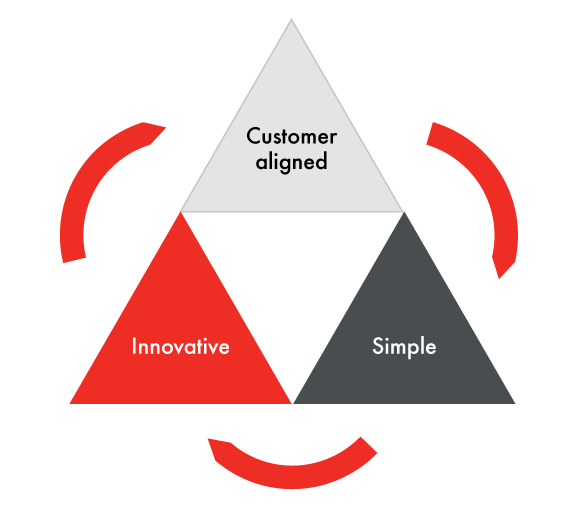
Customer aligned
- Employees know which customer segments we serve and what their top 3 needs are
- Our organisation rallies around these needs (customer facing & support departments)
- We continuously track customer metrics at a transaction, product and business level
- We respond to customer feedback fast
Simple
- We do less, better
- Our customer processes are intuitive
- Our internal processes are as easy as our customer processes
- We routinely identify and eliminate the bottom 30% flow value processes, reporting and meetings
Innovative
- We encourage, empower and reward staff who challenge the status quo
- We launch new ideas fast (< 45 days average)
- We have a full pipeline of ideas linked to incremental volume
- We invest a significant amount annually on innovation
Differentiation for new business growth
Don’t hold your breath waiting for the government to simplify regulation, align their policies with your needs or innovate the country’s way to prosperity. Look at your current structure, reconsider what the business currently offers and determine a positioning that will differentiate you from your competition. Today.
This is just one of the tools UNO uses to ensure when our challenger brand clients invest in marketing, the returns will be worth the effort.
Read More
There are few categories more sophisticated at marketing than fast food. For 50 years McDonalds has been fine-tuning their brand marketing driven machine in Australia. Other brands may talk share of voice or share of wallet, McDonalds is famous for wanting the largest share of stomach in the country.
The business is a great example of how to upsell, cross sell and find new reasons for customers to visit. From breakfast muffins through burgers and happy meals to soft serves and late night treats, washed down by McCafe coffees in between. From Pasta Zu to chicken nuggets to who knows what else a machine can transform animal castoffs into.
Want fries with that?
All of these tactics are an excuse to get more people to buy fries more often, it's where the big profits are made. Makes you wonder how anyone can compete? If you don't work for an omnipotent global business there is evidence of hope. Roy Morgan reasearch released in August 2013 shows just how well new competitors can do by choosing to take a challenger brand positioning.
A case study in how positioning can outsmart the big brands
Hungry Jacks came much later, and has never had the footprint or the ad budget to compete head on. What has worked long term for Jack Cowin's fast food challenger up against a global heavyweight, is a differentiated positioning that gives it a clearly defined space to compete in. "The burgers are better at Hungry Jacks."
From day one they lived up to that positioning statement, better burgers; either with biigger burger patties, actual lettuce instead of a miserable pickled cucumber, to the first Angus beef burger, then bacon and now organic beef. Single mindedly niche focused, and better for it in the minds of customers, who consistently rank Hungry Jacks above Maccas.
Long-term customer satisfaction in fast food comes from smart positioning. Chart: Roy Morgan, August 2013
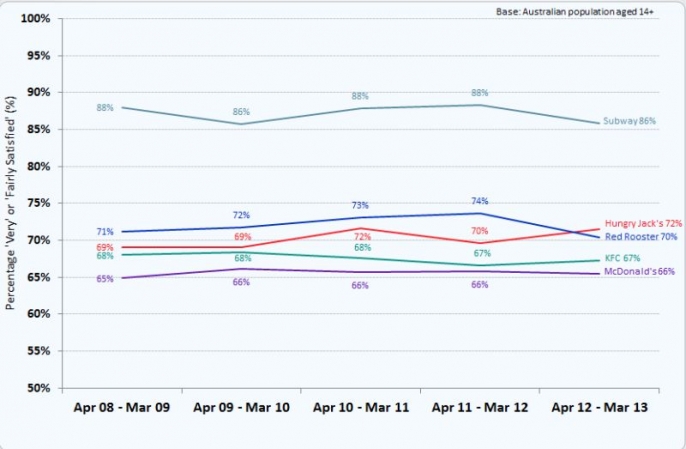
Challenger brands create new terms to compete on
Subway shows the rewards of zigging when the competition zags. While fast food leaders spent their product and promotion strategies on short term price promotion or new themes, from changing with the seasons, think summer pineapple burgers to following fashions, think cajun sauce. Meanwhile Subway went where no fast food had ever successfully gone before: the good for you. positioning.
The chart shows the relative strength of Burger King's "do less of the same, better" approach, and Subway's "do something completely different" model. Both are positively recognised by the consumer and continue to command a price premium to the slower to innovate fast food competition.
What size is a typical marketing budget?

How much is the right amount to invest in marketing?
Depends who you ask. The CMO Council asked hundreds of chief marketing officers around the world across categories how big their budgets are. While this was post GFC, it gives us a useful benchmark when planning ahead.
The starting point for setting a budget uses a top down approach based on your revenue. The chart we've made below shows the percentage of revenue invested in marketing by business to business firms.
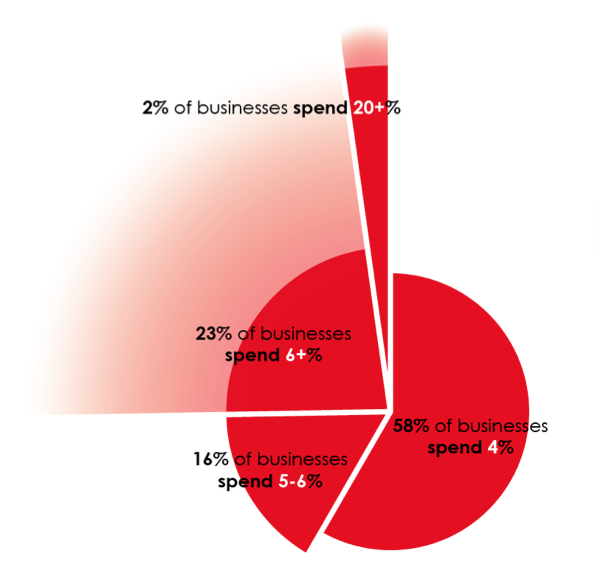
Percentage of revenue invested in B2B marketing
2010 CMO Council Survey
Interestingly, the consensus view amongst those surveyed was that a new brand launch required a minimum investment of 20% of revenue. As we can see from the chart, either there aren't many new brands launched in any year, or the majority aren't spending enough to ensure they don't fail.
Another way of determining the right size of budget is to compare how much is spent according to the size of the business.
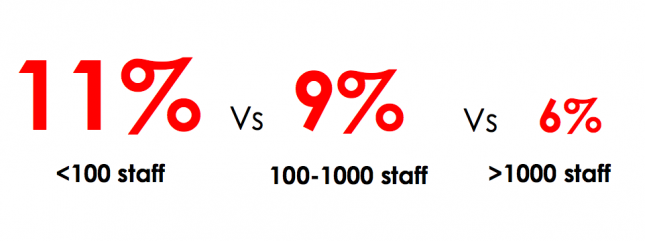
Percentage of revenue invested in marketing by company size
2010 CMO Council Survey
We shouldn't be surprised that as businesses establish themselves and grow, the number of staff grows. As they grow, the relative proportion of their revenue invested in marketing decreases. Marketers understand the long term nature of judging the return on investiment in marketing. Marketing that is consistant delivers compounding returns, a relatively large initial spend will pay dividends in the long term.
Average marketing budget for FMCG brands
A Go-to-Market survey in 2012 found this spread of investment by revenue of FMCG brands:
% of revenue % of companies
No budget 1.1%
0 - 2% 28.6%
3 - 5% 33%
6 - 10% 21.1%
11 - 15% 8.6%
16 - 20% 4.3%
20%+ 3.2%
You can use these percentages as a starting point for framing your marketing budget and then compare to the result of viewing your requirements from a bottom up view.

Bottom up marketing budget approach
Create a list of activities you plan to undertake across your integrated marcomms plan and estimate the required investments for each. Balance and adjust for frequency, reach and coverage. Consider set-up costs for all mediums and a realistic figure for content creation and creative, remembering the better the idea the less times your audience needs to see it to get a result. Factor in research and tracking and an allowance to have the flexibility to react and respond. Remember to allocate around half your total budget for labour, across both internal and outsourced agencies for development and management throughout the year.
Depending on the particular segment your brand is in, the consensus is a B2B marcomms budget needs to be between 3 and 6% of revenue and for FMCG between 6 and 12% to have at least a competitive share of voice.
Read MoreThe most and least trusted professions
Every year Roy Morgan releases a ranking of the trust Australians have for each of the professions. Advertising is down and real estate salesmen up in 2013.
Here are the jobs as they rank for trust in Australia
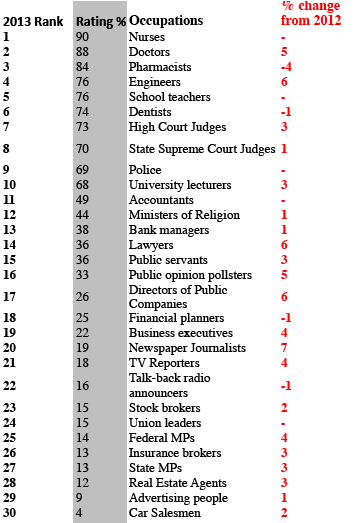
How does this compare on a global basis? See the global trust index.
Read MoreThe Naked truth on Rudd's interview for ads scandal

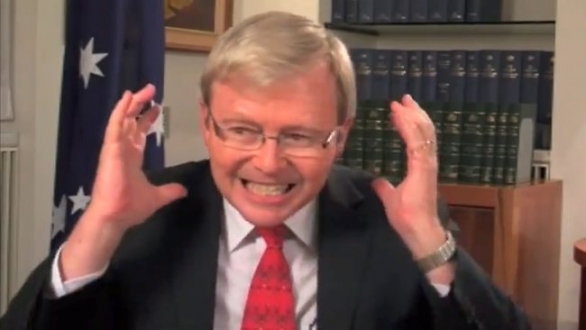
You probably already have an inkling the public rate marketers and ad people at the bottom of the trust scale for professions. You're right, they are down there with politicians. Something happened this week to reinforce the view that neither can be trusted, it's a classic example of an "whatever it takes who cares about the ethics" attitude.
Controversy blew up when Sydney based Naked Communications was exposed while working on a project for Labor when it offered video interviews with PM Kevin Rudd to online youth publishers in return for free online ad space.
Further blurring the lines between “an interview”, and an ad campaign, the agency wrote to Faifax owned The Vine they were “particularly keen for a deeper relationship (including putting investment behind your content on YouTube).”
They also encouraged the online publication to provide “access to pro-Labor or pro-NBN talent.”
When found with their pants down, Naked were fired by Labor. The Sydney Morning Herald’s political reporter, Jonathan Swan, who broke the story, said “it seemed very odd” that Labor was oblivious to the deals offered to online youth sites.
The agency’s CEO claimed no knowledge of the deal, blaming a younger staff member. Indeed, the day after it blew up the agency planner responsible was “no longer in the building”, having left for a holiday in the UK.
What has been adland's reponse to this question of maintaining standards?
Next day the Creative Director of Wonder wrote in AdNews “how much responsibility are we giving young and inexperienced executives? I think too much. Our industry is more impressed by 20-something backward baseball cap-wearing gamers that impress us with their social media savvy than wise old owls. Where are our wise old owls? Nobody could ever accuse the marketing industry as one that eats their young. Quite the opposite, we assassinate the old and we call anyone over 50 old. Mike Wilson (CEO) is Naked’s wise old owl and the bloke is only in his 40s.”
He then suggested the team at Naked vote Abbott to avoid a Labor backlash. This received some wise comments, my favourite from No Wonder of Paddington:
"Wisdom is not the province of age, and this is not an 'odd judgement error'. It's a failure from top down to create a culture of ethics... that at all times forces doing the right thing to trump making a splash for your client. Wilson may be the straight shooter he's characterised here to be, but as the leader of the pack, he's ultimately responsible for the culture that would spawn the actions of that 'rogue executive' who was shown the door"
"This isn't the first time that Naked has been guilty of pushing the envelope at the expense of common sense, and more importantly common decency. What's worse is that the creative drive to market at any expense has had a poisonous influence on the business in general, and in some corners legitimised the art of the stunt and the bad habit of erasing the moral line to such an extent that many of the young guns don't even know it exists."
"It's the agency that should take the fall in the end, not just the employee directly responsible, and encouraging them to vote for Abbott in an attempt to avoid the negative reaction from everyone that they richly deserve shows us all just how jaded the industry at large has become. Sad and sadder."
SMH's Swan labeled the agency “a bit wild west, they’ve got a cowboy reputation” and said they have a history of “doing things a bit off-piste”. Swan also mentioned the infamous fake Facebook Witchery coat campaign which duped both mainstream media and social media users in 2009.
When does online content become advertising?
According to the ACCC and AANA it’s one and the same in the eyes of the law, as we can see from the new Code on marketing communications that encompases social media.
Gabriel McDowell, MD of PR firm Res Publica pointed out the new risks inherent in attempting to leverage digital channels: “From a crisis management perspective, and based on the reported facts so far, I think the ALP has reacted promptly and appropriately to try to limit reputational damage to the Labor brand. They have made it clear they didn’t sanction the offending proposal and firing the responsible agency was a justifiable response given the seriousness of its misjudgement.
"And there can be no doubt that it is a whopper of a misjudgement because building trust and understanding between a brand and its public is the fundamental objective of any communication campaign and deliberately blurring the lines between editorial and advertising can only erode trust when it is uncovered.”
"It has never happened before. My mouth was on the ground. Young people are politically engaged and this is not the way to go about appealing to them. It is why we tend to shy away from the major parties."
She told AdNews it was "exactly the sort of thing that is killing media", but that brands generally grasped the value of editorial over paid content.
The challenge for the communications industry is while we may have self-regulation, only a handful of agencies are Accredited by the Communications Council. UNO is, Naked isn't and most clients don't appreciate the difference. As I commented to AdNews, "what's the point of having an agency Accreditation scheme when people arrive at work having forgotten to pack the moral compass. If we want to be regarded higher than real estate salesmen, which the latest research shows we don't, both clients and agencies need to keep briefs away from the irresponsible."
Will digital spell the end of editorial integrity?
This has all happened less than a week after Adnews editor-in-chief Paul McIntyre expressed a fear for the future of publishing as the title becomes a defacto re-publisher of PR releases and sponsored events. This is what he said in an open editorial:
"Change can be painful but equally stimulating. Just as long the industry knows where it’s all headed and in what direction it is pushing its industry media. It won’t be too far away, for example, when you all can hack back your budget for PR operatives. And PR types, brace for a much harder slog. Seriously, most of you won’t be needed. The deluge of PR-generated ideas and story angles is rising rapidly while the ability for business-to-business media to cover it is declining at the same pace. Don’t forget that. Okay, sorry, rant over."
Read More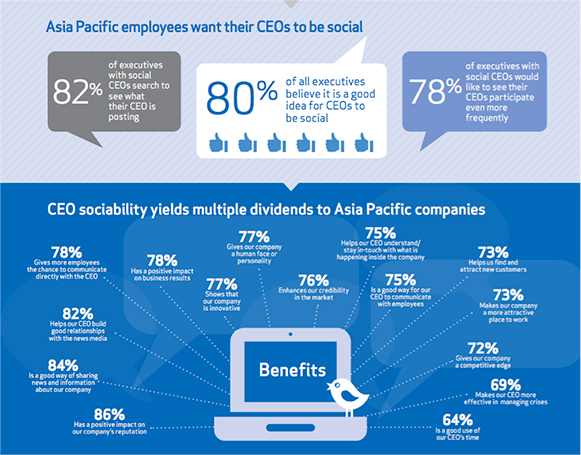
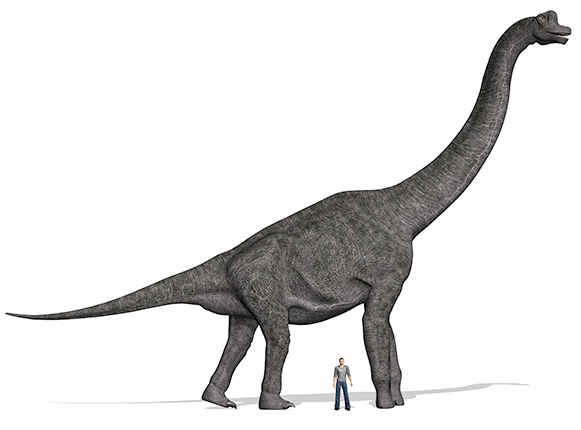





Scan the QR code for our contact details.
Download the Neoreader app.
© COPYRIGHT 2013 UNO marcomms Privacy